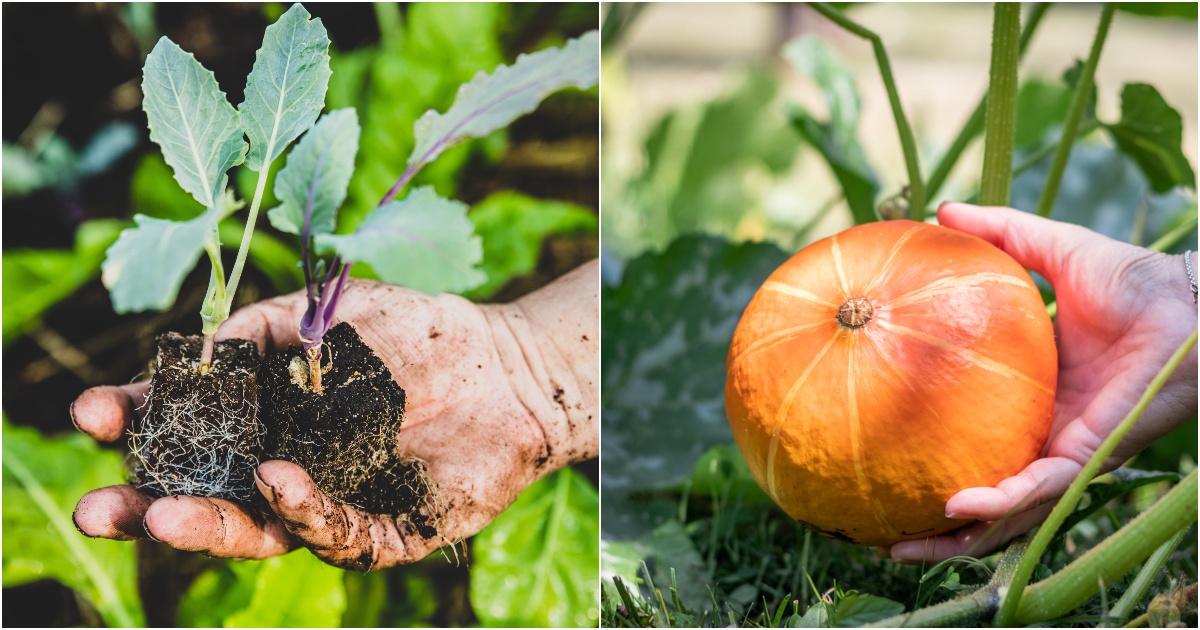
One astonishing thing we discover early on in our gardening odyssey is what fruits and vegetables should actually taste like.
What we buy from the store is a shockingly watered-down version; what we grow in our gardens is bold, aromatic, and so intensely flavorful!
Garden to table really is the pinnacle of healthy eating. Those strong scents, bright colors, and deep flavors are an excellent indication that the food is plentiful in vitamins, minerals, and other essential micro nutrients.
When you grow food in soil enriched with organic matter and harvest it at peak ripeness, you can be sure it will be teeming with the good stuff. And any fruit or veggie you love to eat will always be well worth your time and energy to grow.
20 Most Nutrient Dense Garden Crops
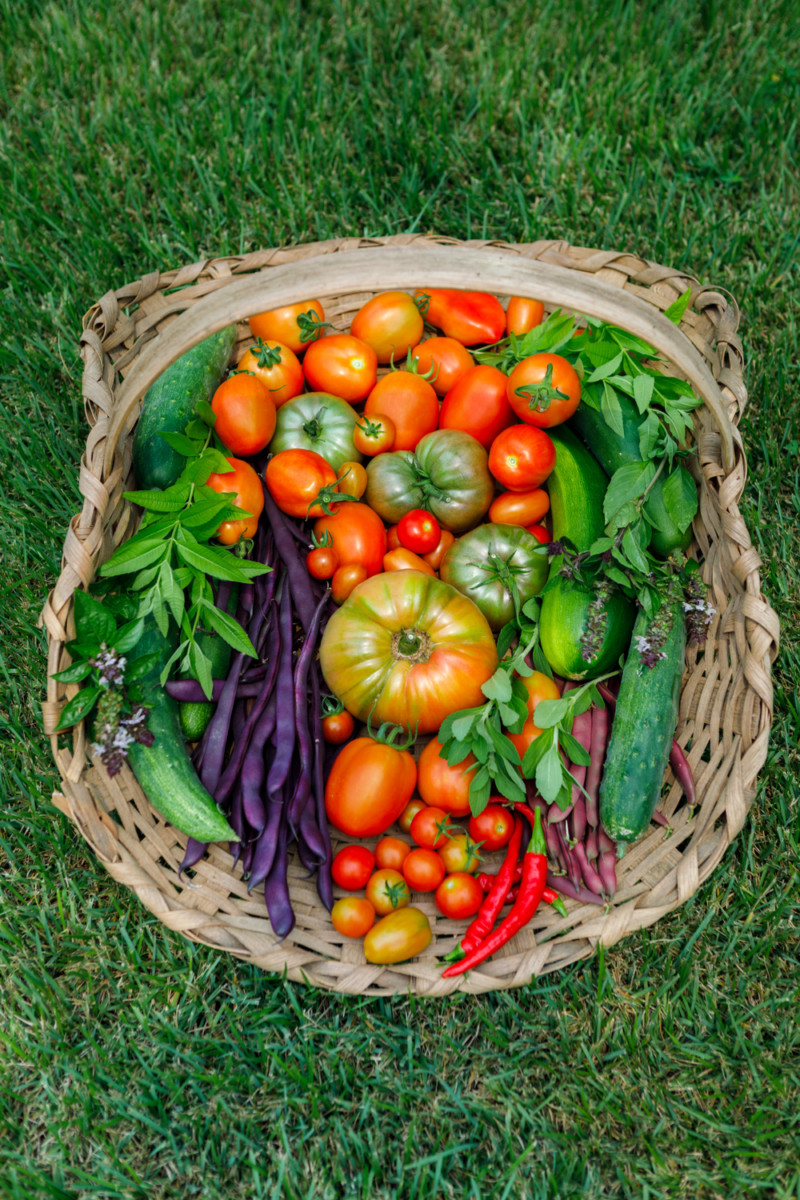
Beyond delicious garden fresh fare, we can also choose to grow foods for their awesome health-promoting properties.
You might be surprised to learn what crops are the most nutritious. It turns out that, gram for gram, cruciferous vegetables and leafy greens contain the highest amount of essential nutrients for the fewest amount of calories.
Per the 2014 study, Defining Powerhouse Fruits and Vegetables, researchers evaluated 47 garden-variety crops for 17 key nutrients for good health – vitamins A, B6, B12, C, D, E, and K, as well as protein, potassium, calcium, iron, thiamin, riboflavin, niacin, folate, zinc, and fiber.
Each food was given a nutrient density score based on the mean percent of daily values (DVs) they provide, for every raw 100 gram serving. Here are the top crops, ranked by nutritional value:
1. Watercress

Watercress (Nasturtium officinale) is a semi-aquatic perennial herb in the Brassica family that naturally grows along slow-flowing creeks and streams.
Topping the nutrient-density rankings with the only perfect score, watercress is a true powerhouse that contains a broad spectrum of health-promoting nutrients.
At just 11 calories per serving, watercress is an excellent source of vitamin C (72%), vitamin A (64%), and vitamin K (100%) with a decent amount of calcium (12%), potassium (9%), riboflavin (7%), vitamin B6 (6%), thiamin (6%), and vitamin E (5%) to boot.
Growing this water-loving plant isn’t hard to do as long as you always keep its feet wet. A water feature would be the perfect milieu, but you can also grow watercress in homemade bogs, or in nesting pots, or as a microgreen on the windowsill.
Nutrient density score: 100/100
Hardiness zone: 5 to 10
Sun exposure: Full sun to part shade
2. Bok Choy
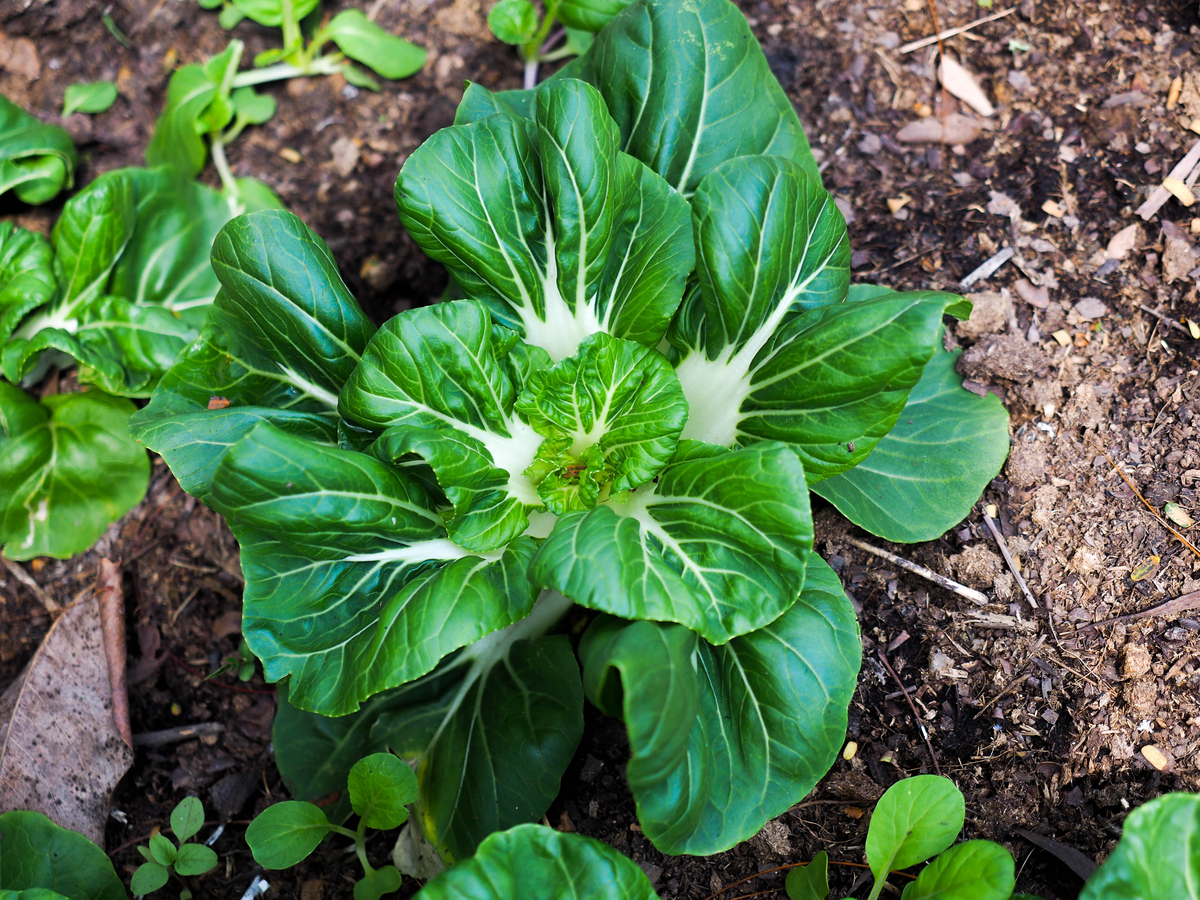
Chinese cabbage (Brassica rapa var. chinensis) – or bok choy as it’s more popularly known – is a cool season, cut-and-come-again crop that you can start harvesting in roughly 45 days.
With a mouthfeel similar to spinach, but sweeter and crunchier, bok choy is chock full of valuable nutrients – vitamin A (89%), vitamin C (75%), vitamin K (57%), folate (16%), vitamin B6 (10%), calcium (11%), potassium (7%), and iron (4%) – for each 13 calorie serving.
Boy choy is easy to grow and can yield an abundance of leafy greens through spring and early summer. It’s especially delectable in stir fries, but there’s so many other yummy ways to incorporate more bok choy into your diet.
Nutrient density score: 92/100
Hardiness zone: Annual; biennial in zones 4 to 7
Sun exposure: Full sun to part shade
3. Swiss Chard

Swiss chard (Beta vulgaris var. vulgaris) is a handsome leafy vegetable with large, ruffled deep green leaves on vibrant stems in red, yellow, or white.
As a cut-and-come-again plant, you can snip away at Swiss chard all season long.
The leaves and ribs, mild and slightly sweet, are an excellent source of vitamin A (100%), vitamin K (100%), and vitamin C (50%). At a mere 19 calories, Swiss chard also contains potassium (11%), iron (10%), vitamin E (9%), fiber (6%), vitamin B6 (5%), and riboflavin (5%).
You can substitute Swiss chard in any recipe that calls for spinach – here’s seven tasty ways to get you started.
Nutrient density score: 89/100
Hardiness zone: Annual; biennial in zones 6 to 10
Sun exposure: Full sun to part shade
4. Beet Greens
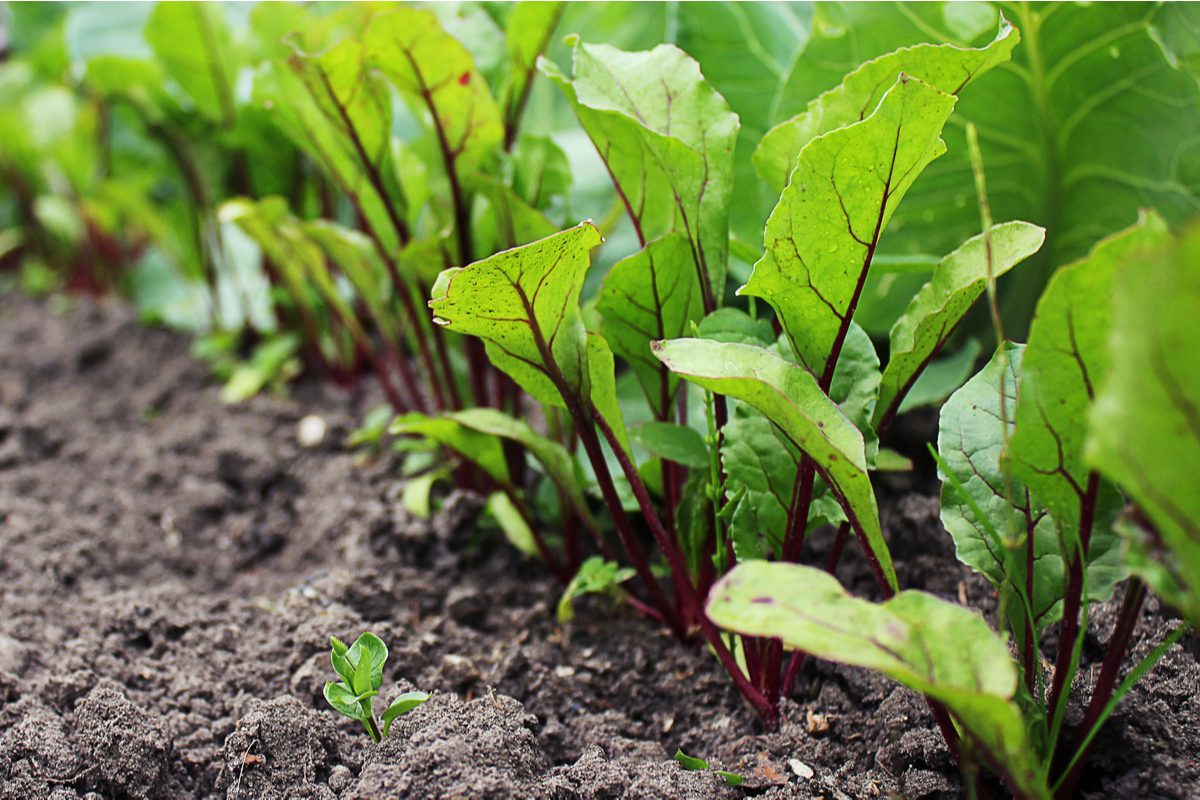
Beets (Beta vulgaris) can take anywhere from 40 to 70 days to develop the tasty taproots below the surface. While you wait for the root vegetable to grow, you can enjoy the leafy tops once plants are 4-inches tall.
Beet greens are 22 calories per 100 gram potion, and are loaded with vitamin A (100%), vitamin K (100%), and vitamin C (50%), along with potassium (22%), fiber (15%), iron (14%), riboflavin (13%), calcium (12%), vitamin E (7%), thiamin (7%), and folate (4%).
The leaves are mildly sweet, reminiscent of spinach and Swiss chard. When picking beet greens, make sure to leave some leaves back on the plant so that the beetroot can continue to grow and swell.
Nutrient density score: 87/100
Hardiness zone: Annual
Sun exposure: Full sun to part shade
5. Spinach

Spinach (Spinacia oleracea) is a great little performer in the garden. Fast growing and cold hardy, you can begin to harvest it in about a month after sowing.
And spinach certainly does a body good. Each serving of the leafy greens contains vitamin A (100%), vitamin K (100%), vitamin C (47%), folate (49%), potassium (16%), iron (15%), riboflavin (11%), calcium (10%), vitamin B6 (10%), fiber (9%), and protein (6%). All for just 23 calories.
Double your spinach harvests by sowing seeds in early spring and then again in late summer.
Nutrient density score: 86/100
Hardiness zone: Annual
Sun exposure: Full sun to part shade
6. Leaf Chicory
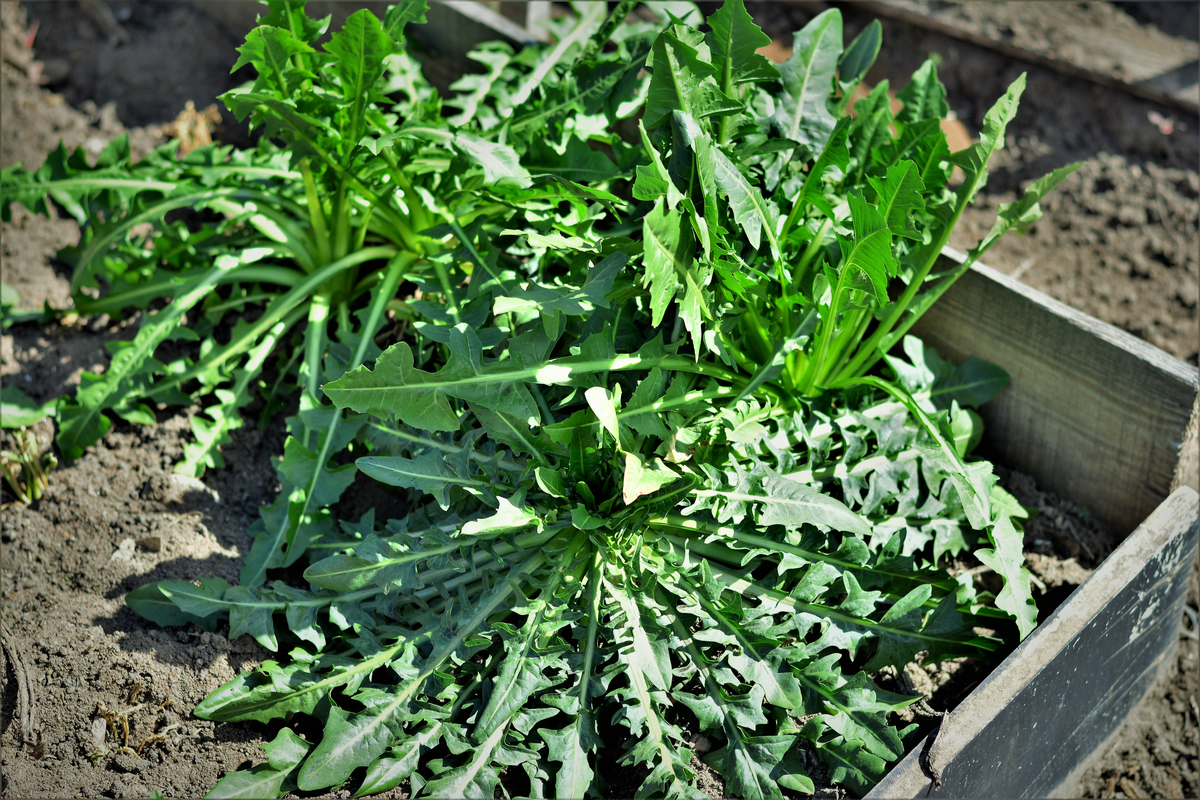
Common chicory (Cichorium intybus) is a wild type of chicory that has naturalized throughout much of the US.
A perennial wildflower, chicory leaves grow in a rosette and are deeply lobed and toothy. They look almost identical to dandelion leaves. Chicory leaves get bitter with age and taste best when they are harvested while still young and tender.
At 23 calories per serving, chicory greens are rich in vitamin A (100%), vitamin K (100%), and vitamin C (40%). They are also a good source of folate (27%), fiber (16%), vitamin E (11%), potassium (12%), calcium (10%), and riboflavin (6%).
Nutrient density score: 73/100
Hardiness zone: 3 to 8
Sun exposure: Full sun
7. Leaf Lettuce
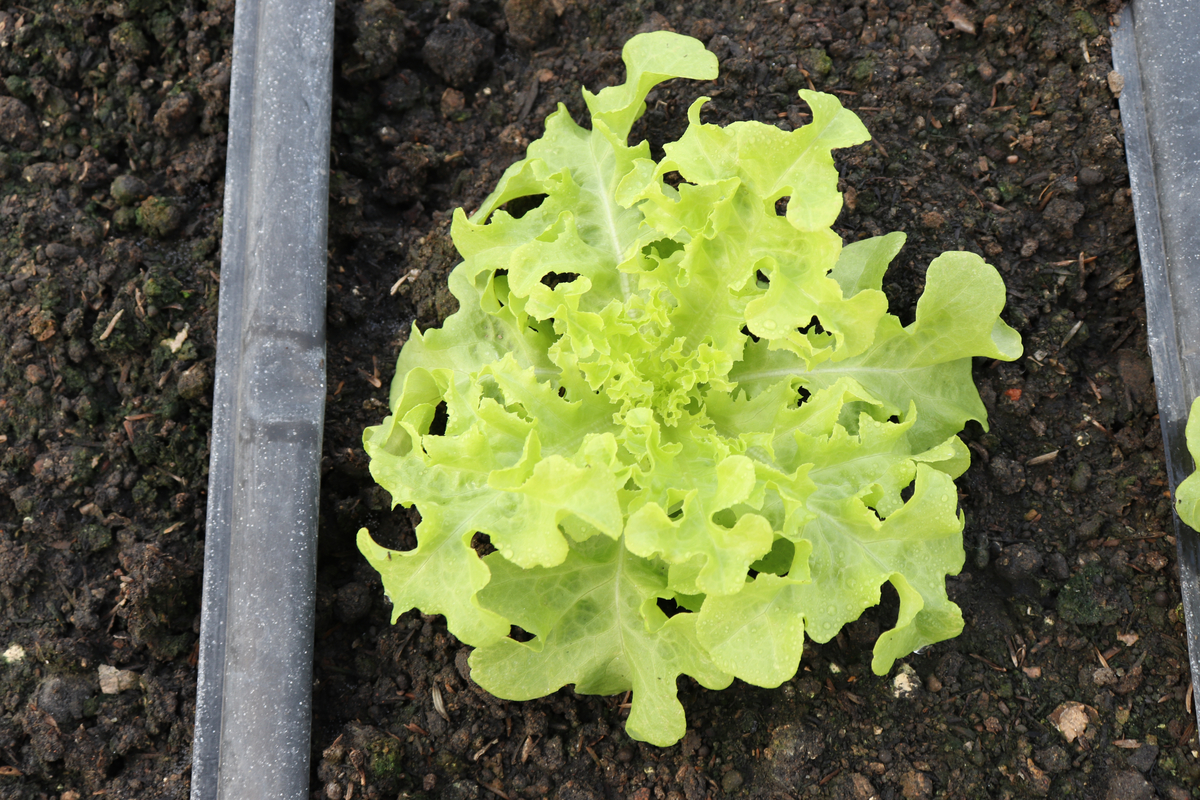
Of the four basic types of lettuce (Lactuca sativa), leaf lettuce is the easiest to bring to harvest. Instead of forming tight heads, leaf lettuce grows in looser clumps.
Green leaf lettuce varieties are a bit more nutritious than the red leaf varieties, with higher amounts of vitamin A (100%), vitamin K (100%), and vitamin C (30%) for each 100 gram serving. At only 15 calories, leaf lettuce provides folate (10%), potassium (6%), iron (5%), thiamin (5%), and riboflavin (5%) as well.
Give loose leaf lettuce the cut-and-come-again treatment to get the most out of these salad greens.
Nutrient density score: 70/100
Hardiness zone: Annual
Sun exposure: Full sun to part shade
8. Parsley

Parsley (Petroselinum crispum) is a biennial herb with a distinctive flavor that is clean, fresh, and slightly earthy. It’s so much more than just a garnish, and there’s lots of ways to incorporate more parsley into your meal prep.
Those feathery, tripinnate leaflets are 36 calories per serving, and are bursting with vitamin A (100%), vitamin C (100%), and vitamin K (100%). There’s also plenty of folate (38%), iron (34%), potassium (16%), calcium (14%), and fiber (13%), to go around, with smaller amounts of niacin (7%), protein (6%), thiamin (6%), and riboflavin (6%).
Let your parsley plants flower in their second year and you’ll have yourself a permanent parsley patch in the garden.
Nutrient density score: 66/100
Hardiness zone: Biennial in zones 5 to 9
Sun exposure: Full sun to part shade
9. Romaine Lettuce
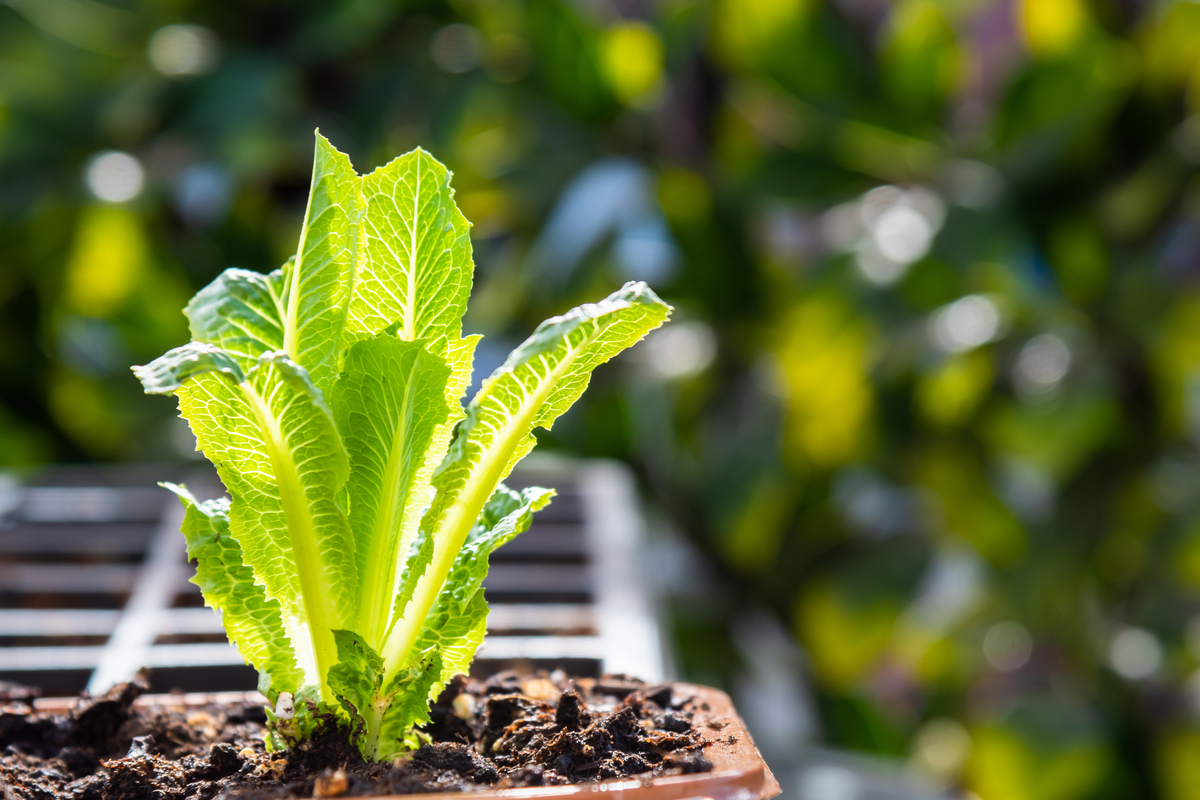
Romaine lettuce (Lactuca sativa var. longifolia) is a tad trickier to grow than loose leaf varieties, but it’s so worth the learning curve for the very finest Caesar salad greens.
The crunchy leaves are 17 calories for 100 grams, and have loads of vitamin A (100%), vitamin K (100%), vitamin C (40%), and folate (34%). They’re also a good source of fiber (8%), potassium (7%), and thiamin (5%).
Though romaine lettuce is more heat-resistant than other lettuce types, it will still perform best in the cooler conditions of spring and fall.
Nutrient density score: 63/100
Hardiness zone: Annual
Sun exposure: Full sun to part shade
10. Collard Greens

Collards (Brassica oleracea var. acephala) are a loose leaf, non-heading kind of cabbage that’s sweet, nutritious, and easy to grow.
The smooth green leaves are a superb source of vitamin A (100%), vitamin K (100%), vitamin C (59%), and folate (41%). For 30 calories a serving, collards have a fair quantity of calcium (14%), fiber (14%), riboflavin (8%), and protein (5%) too.
Though collards are often associated with Southern cooking, these greens are used in a myriad of cuisines from all over the world.
Nutrient density score: 62/100
Hardiness zone: Annual
Sun exposure: Full sun to part shade
11. Turnip Greens
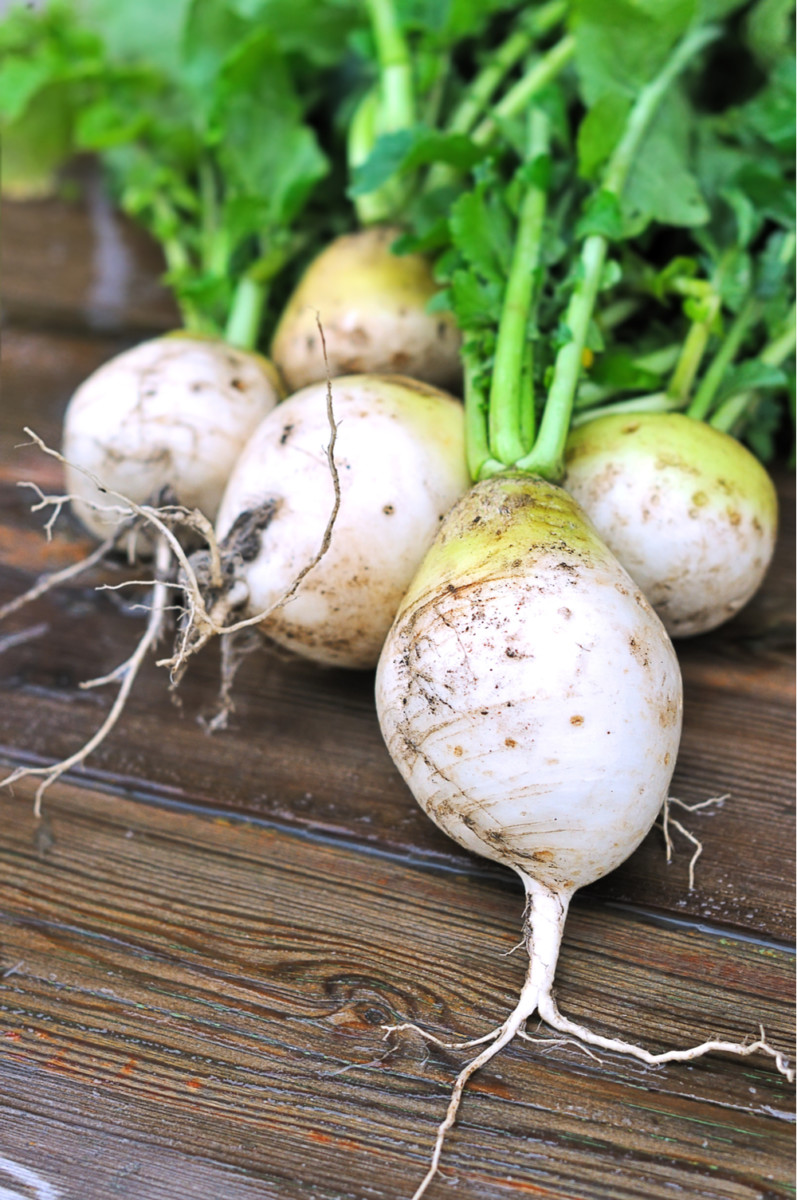
Turnips (Brassica rapa var. rapa) are ready to get pulled from the ground 35 to 55 days after planting. And just like beets, you can start plucking away at turnip greens once plants are 4-inches tall.
Tasting sweet with a little mustardy bite, turnip tops are brimming with vitamin A (100%), vitamin C (100%), vitamin K (100%), folate (49%), calcium (19%), vitamin E (14%), vitamin B6 (13%), fiber (13%), and riboflavin (6%). Each 100 gram portion is 32 calories.
Use baby turnip greens to add some zing to fresh salads. The tougher, older leaves can be cooked the same as kale, collards, or Swiss chard.
Nutrient density score: 62/100
Hardiness zone: Annual
Sun exposure: Full sun to part shade
12. Mustard Greens
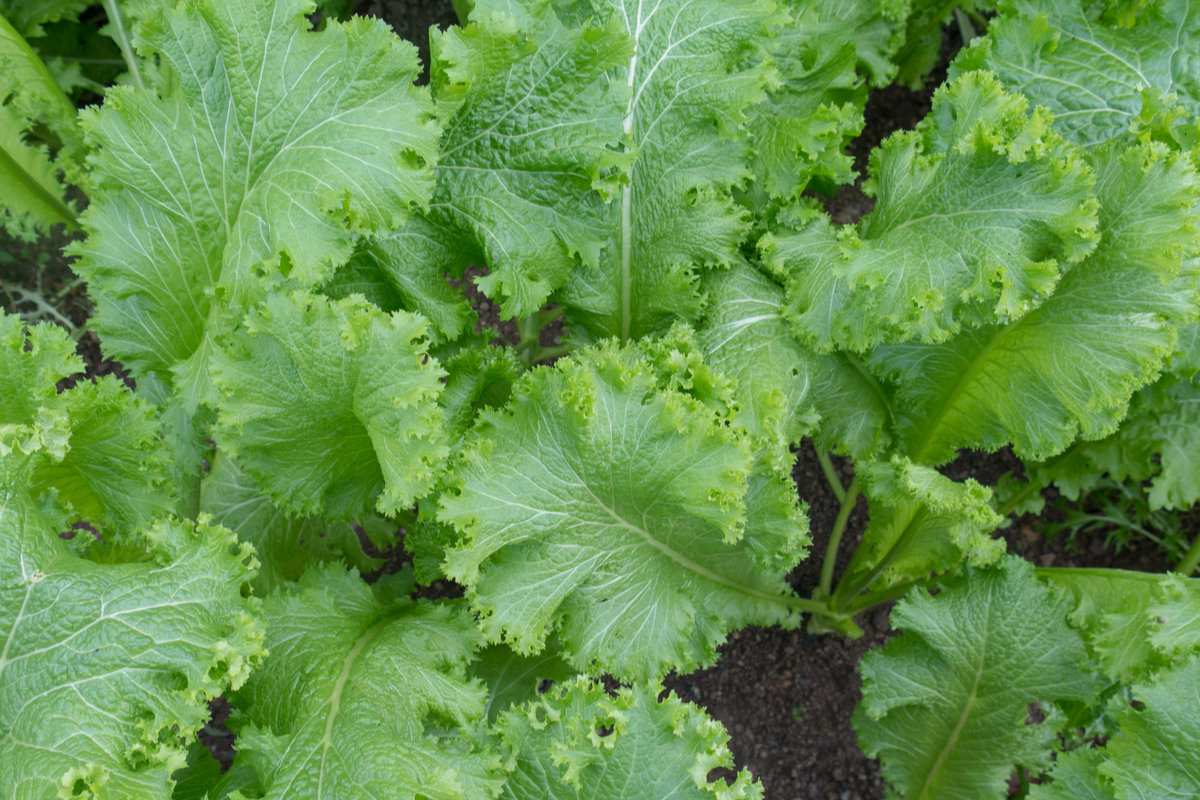
Brown mustard (Brassica juncea) is a cruciferous wildflower, cultivated for its hot and spicy leaves, flowers, and seeds.
The punchy mustard greens are loaded with vitamin A (100%), vitamin C (100%), vitamin K (100%), and folate (47%), supplying some extra fiber (13%), vitamin E (10%), calcium (10%), potassium (10%), vitamin B6 (9%), and iron (8%), for 26 calories per serving.
Young, tender baby mustard greens are sweet and spicy and can be plucked when 3 to 4 inches in length. Older leaves are more bitter, but can be boiled, steamed, or sautéed for better flavor.
Nutrient density score: 61/100
Hardiness zone: Annual
Sun exposure: Full sun to part shade
13. Endive
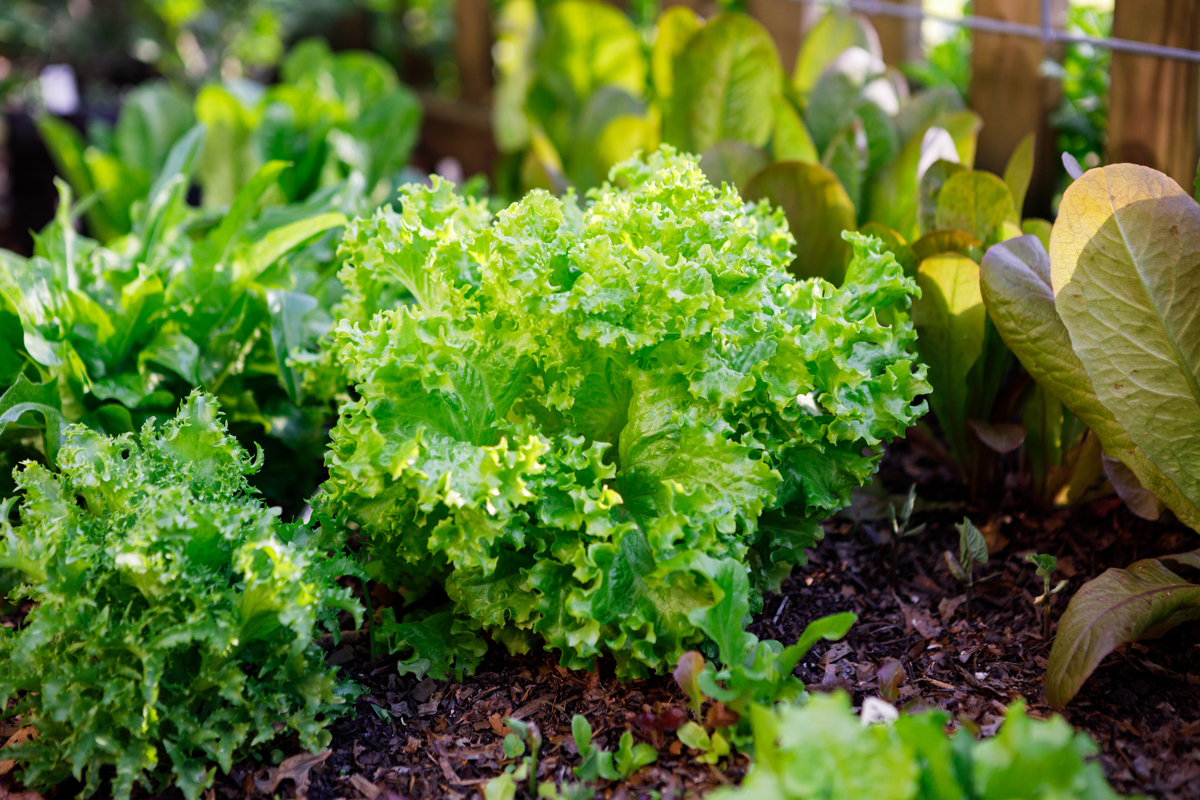
Not to be confused with Belgian endive or radicchio, endive (Cichorium endiva) is a leafy green that grows in a cabbage-like rosette.
There are two main varieties of endive – curly (frisee) and broad-leaved (escarole). Endive leaves taste slightly bitter, offering a good bit of pucker in mixed greens or as a flavoring for sweet and sour dishes.
Endive is a cut-and-come-again vegetable that supplies an array of nutrients for each 17 calorie, 100 gram serving: vitamin K (100%), vitamin A (43%), folate (35%), fiber (12%), vitamin C (11%), potassium (9%), thiamin (5%), calcium (5%), iron (5%), and zinc (5%).
Nutrient density score: 60/100
Hardiness zone: Annual; biennial in zones 4 to 9
Sun exposure: Full sun to part shade
14. Chives

Chives (Allium schoenoprasum) are one of the most productive and practical perennial herbs you can grow.
Having chives in the garden entices good insects while repelling the baddies, and all the while you can harvest their oniony, garlicky shoots through summer and fall.
The grassy greens are exceptionally nutrient dense, so you’ll want to take advantage. For every 30 calorie serving, chives are fortified with vitamin K (100%), vitamin C (97%), vitamin A (87%), folate (26%), fiber (10%), calcium (9%), iron (9%), potassium (8%), and protein (7%).
Chives go well with nearly any savory food you can throw at it. Sprinkle them everywhere you can to bump up your chives consumption.
Nutrient density score: 55/100
Hardiness zone: 3 to 9
Sun exposure: Full sun to light shade
15. Kale

Kale (Brassica oleracea var. acephala) has long been heralded for its super food status. And this leafy cabbage is indeed a nutrient powerhouse.
Ranging from bitter to sweet, kale leaves have an earthy flavor that’s rich in vitamin A (100%), vitamin C (100%), and vitamin K (100%). At 50 calories per serving, they are another good source of vitamin B6 (14%), calcium (14%), potassium (13%), iron (9%), fiber (8%), and protein (7%).
Kale is happiest in cooler climes and grows best in spring and fall temperatures. To really rock your taste buds, let you kale plants get kissed by frost late in the season for the sweetest leaves ever.
Nutrient density score: 49/100
Hardiness zone: Annual; biennial in zones 7 to 9
Sun exposure: Full sun to part shade
16. Dandelion Greens
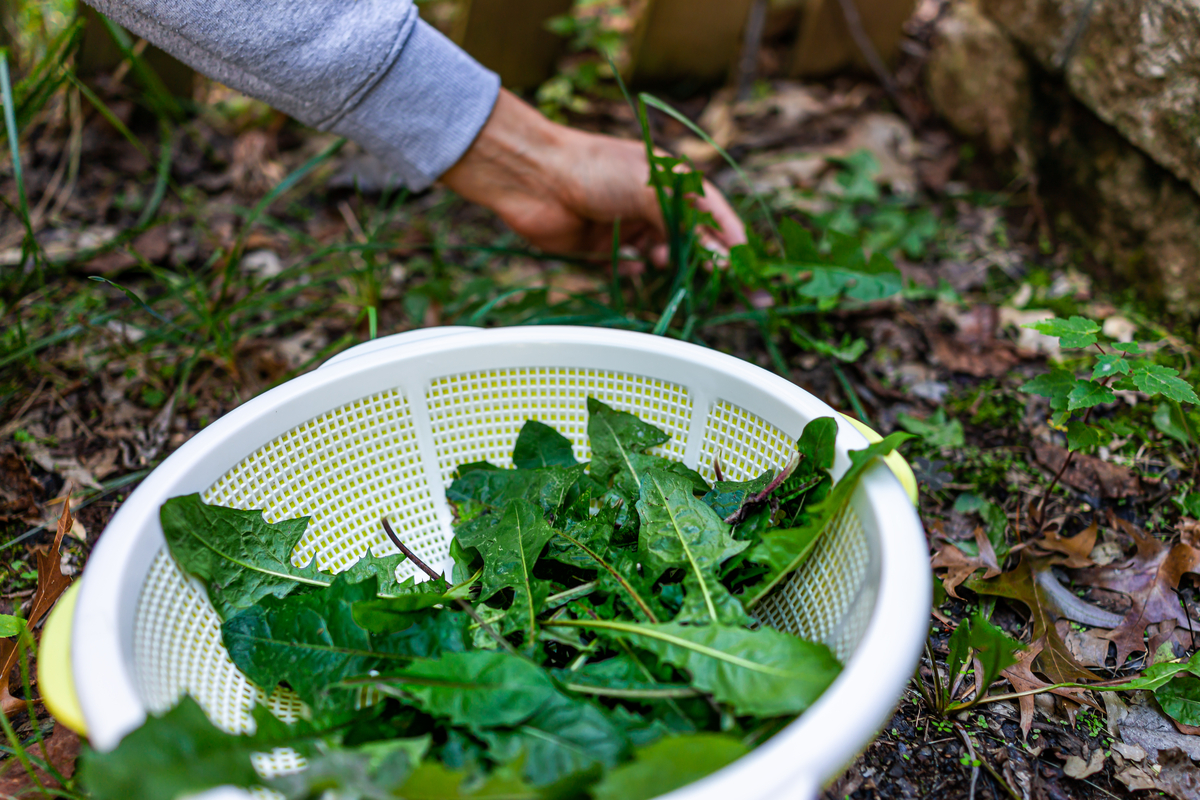
Growing just about anywhere, dandelions (Taxaxacum officinale) pop up on lawns and gardens with their fluffy yellow flowers from March to May.
Dandelions are truly tenacious and quite possibly the world’s most “perfect” weed. As a pioneer species, these wildflowers are an important part of the early spring ecosystem, providing nectar to bees, butterflies, moths, beetles, and other wildlife.
All parts of the dandelion plant are edible and it’s easy enough to forage them from your own backyard. The roots can be made into coffee, the flowers into wine, and the leafy greens are packed to the gills with nutrition.
Dandelion greens are 45 calories per serving and provide vitamin A (100%), vitamin K (100%), vitamin C (58%), calcium (19%), iron (17%), riboflavin (15%), fiber (14%), thiamin (13%), vitamin B6 (13%), potassium (11%), and folate (7%).
The younger leaves are the least bitter, with a more tangy, earthy, and nutty flavor than the older stock. Peruse these dandelion greens recipes for inspired ways to use them in the kitchen.
Nutrient density score: 46/100
Hardiness zone: 3 to 9
Sun exposure: Full sun to part shade
17. Red Pepper
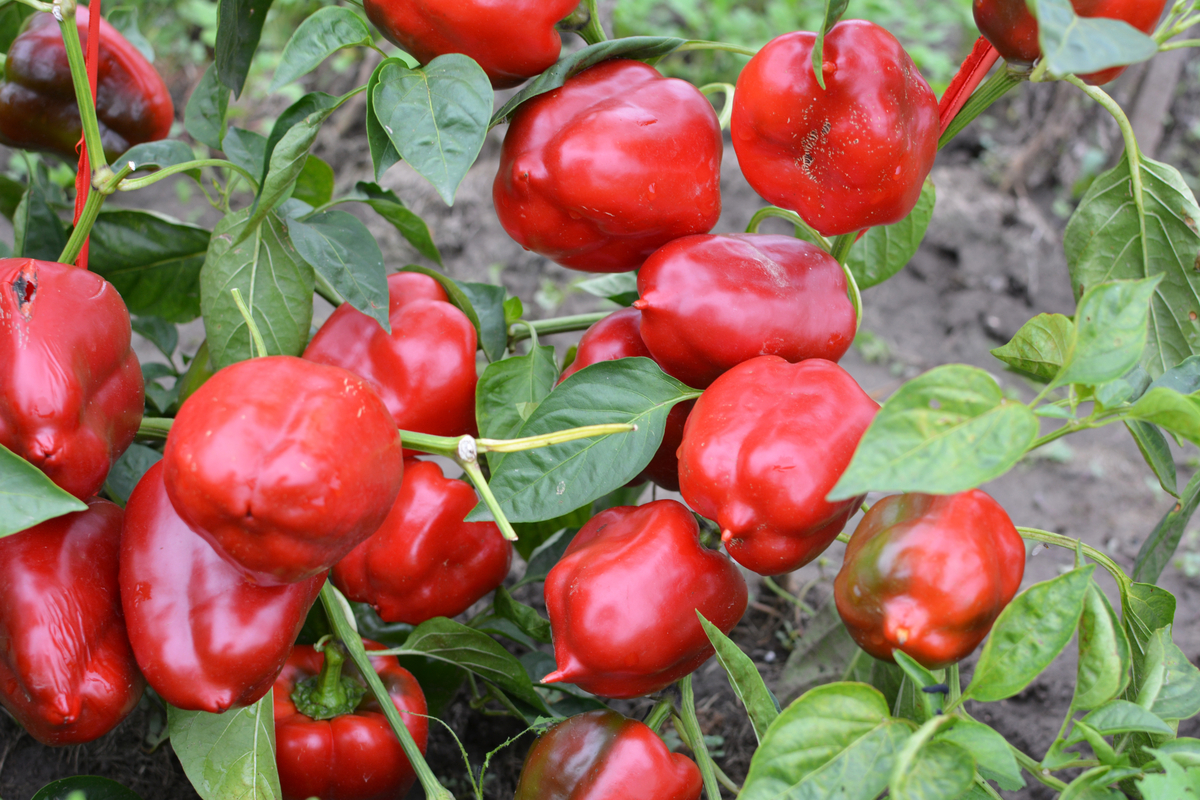
Sweet peppers (Capsicum annuum) come in a rainbow of colors – green, red, yellow, orange, brown, white, lavender, and dark purple – but it’s the red varieties that are the most packed with nutrients.
At 31 calories per serving, red peppers are flush with vitamin C (100%), vitamin A (63%), vitamin B6 (15%), folate (11%), vitamin E (8%), fiber (8%), niacin (5%), and riboflavin (5%).
Red peppers have 9 times the vitamin A and twice the vitamin C as green peppers. Unless you’re growing a permagreen cultivar, waiting until your green peppers have ripened to red before harvesting will provide a sizeable boost in vitamin content.
Nutrient density score: 41/100
Hardiness zone: Annual
Sun exposure: Full sun
18. Arugula

Arugula (Eruca vesicaria var. sativa) is yet another fast growing, cool season leafy green that’s ready for its first round of harvests in spring.
Peppery and tart, arugula leaves are high in vitamin K (100%), vitamin A (47%), and vitamin C (25%), with folate (24%), calcium (16%), potassium (11%), iron (8%), fiber (6%), and protein (5%) for every 25 calorie serving.
Sow arugula seeds before the last frost date to really ramp up your yields.
Nutrient density score: 38/100
Hardiness zone: Annual
Sun exposure: Full sun
19. Broccoli

A mainstay in the vegetable garden, broccoli (Brassica oleracea var. italica) is a flowering cabbage that prefers the cooler ends of the growing season.
And as it so happens, parents everywhere were absolutely right – eating your trees really is good for you. Each 100 gram serving is 34 calories, while supplying vitamin C (100%), vitamin K (100%), folate (16%), vitamin C (12%), fiber (10%), vitamin B6 (9%), potassium (9%), riboflavin (7%), and protein (6%).
Broccoli crowns are topped with tiny immature flower buds. The trick to successfully bringing broccoli to harvest is to promptly remove the heads before the yellow flowers begin to open up.
Nutrient density score: 35/100
Hardiness zone: Annual
Sun exposure: Full sun
20. Pumpkin

Pumpkin (Cucurbita pepo) is a vining warm season crop that blooms in July for a huge melon harvest in fall. The pumpkin plant is almost entirely edible too – seeds, flowers, leaves, and inner flesh – everything but the thick rind.
It’s the orange innards that offer the most nutrients per serving though. Pumpkin flesh is particularly high in vitamin A (100%), and has a bit extra in vitamin C (15%), potassium (10%), riboflavin (6%), and vitamin E (5%) for only 26 calories.
Render it into pumpkin puree to make gads of sweet and savory dishes that go well beyond pumpkin pie.
Nutrient density score: 34/100
Hardiness zone: Annual
Sun exposure: Full sun

Get the famous Rural Sprout newsletter delivered to your inbox.
Join the 50,000+ gardeners who get timely gardening tutorials, tips and tasks delivered direct to their inbox.

